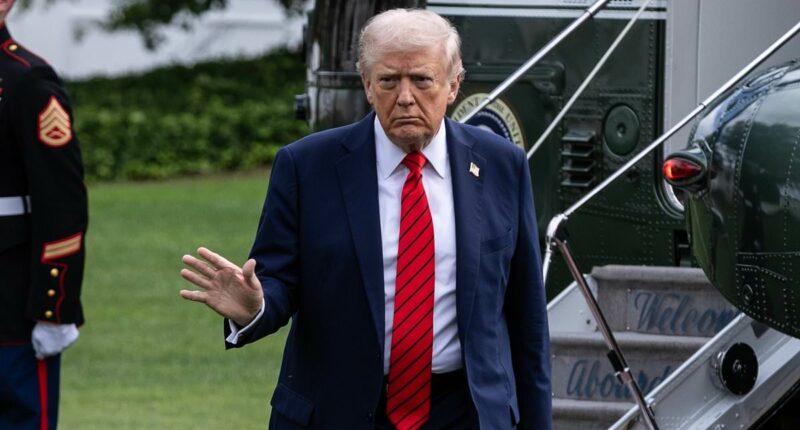Share this @internewscast.com
The agency responsible for managing America’s nuclear arsenal has issued a stern warning about the “dire consequences” of the ongoing US government shutdown, as it prepares to furlough employees for the first time in its history. This development adds mounting pressure on President Donald Trump to resolve the impasse in Washington.
Today, the National Nuclear Security Administration (NNSA) is set to notify 1,400 staff members of their furloughs, with fewer than 400 employees expected to remain on duty as the shutdown stretches into its 20th day.
Chris Wright, the Secretary of the Department of Energy, confirmed this unprecedented decision, emphasizing that the affected workers play a crucial role in the modernization of the nation’s nuclear arsenal.
The NNSA is tasked with maintaining national security by ensuring a robust stockpile of nuclear weapons and monitoring nuclear proliferation globally. Their primary mission is paramount to national defense and international stability.
This furlough marks an historical first for the NNSA. Ben Dietderich, a spokesperson for the Energy Department, conveyed to CNN that since the agency’s inception in 2000, it has never before been forced to furlough workers due to funding shortfalls.
“We are left with no choice this time,” Dietderich stated. “We’ve extended funding as long as we could, but the circumstances have made it unavoidable.”
‘The longer the shutdown lasts, the more damaging and dire the consequences will be for workforce retention and weapons modernization efforts critical to national security.’

Pantex in Texas (pictured) will be among the hardest hit by the furloughs beginning on Monday, insiders say

The Trump administration will on Monday begin furloughing employees at the National Nuclear Security Administration as the government shutdown drags into a 20th day
The furloughs will begin at NNSA sites responsible for assembling nuclear weapons -Pantex in Texas and Y-12 in Tennessee – and will effectively force the locations to enter a safe shutdown mode.
A second source told CNN contractors will continue to undertake the work they can until they run out of money, but that could happen as soon as October 28.
From that point onwards, the Department of Defense is at serious risk of failing to receive weapons deliveries.
‘Everything would be locked up,’ the source said.
The NNSA works around the world to secure dangerous nuclear materials, including in Ukraine as the war with Russia drags on. Back in June, the US struck Iran’s nuclear facilities in an effort to set back the nation’s nuclear capacity.
The process of stopping work mid-operation is also potentially dangerous and time consuming.
‘To stop in the middle of disassembling or building a nuclear weapon, there are several steps you must take to ensure everything is safe enough to leave and lock up,’ the source said.

Y-12 in Tennessee (pictured) is also expected to be hit hard by the government shutdown

The facilities are responsible for assembling and storing America’s nuclear weapons arsenal (pictured, employees at Pantex)
‘And then when you come back, you have to do all of that in reverse to restart. It takes time, it’s not like flipping a light switch.’
Daryl Kimball, the executive director of the Arms Control Association said the NNSA performs essential work for ‘nuclear facility safety and security.’
He said: ‘I am sure they can find the funds to keep the workers on the job, or else they might want to rethink their position on the federal government shutdown.
In spite of the mounting concerns, insiders have assured the American public that there is no immediate concern for national security.
‘The nuclear stockpile today is reliable and can accomplish what it’s designed to do,’ they said.
‘But if we can’t continue our modernization, refurbishing, doing surveillance, then it’s the reliability of the stockpile that’s affected, and it’s going to take some time to play catch up on all of that work.’
Security staff will remain on the job to guard the facilities and the weapons.
NNSA’s federal staff oversees some 60,000 contractors maintaining and testing weapons at national laboratories and other locations across the United States.

NNSA’s federal staff oversees some 60,000 contractors maintaining and testing weapons at national laboratories and other locations across the United States. Pictured: Employees handling a weapon at Pantex facility in Texas
Wright warned there could be tens of thousands of layoffs of contractors along with furloughs of staff workers due to the shutdown, now on its 20th day.
‘We’re just getting momentum… To have everybody unpaid and not coming to work, that will not be helpful.’
The costs of operating and modernizing America’s nuclear forces through 2034 are projected to soar to $946 billion, 25 percent higher than a 2023 estimate, a report by the non-partisan Congressional Budget Office said in April.
Nuclear weapons expenditures are divided between the Pentagon and the NNSA.
Wright will address the impacts of the shutdown on the nation’s nuclear weapons arsenal when he visits the National Nuclear Security Site in Nevada on Monday.
The federal government shutdown is quickly approaching the second longest on record with no end in sight. Some lawmakers are predicting it could become the longest, surpassing the 35 days from Trump’s first term.
The Trump administration is using the current shutdown to buttress priorities it favors while seeking to dismantle those it doesn’t.
Nevertheless, Democrats are insisting that any funding bill include help for millions of Americans who will lose health insurance coverage or face dramatically higher monthly premiums if Congress does nothing.
The federal government employed nearly 2.3 million civilian employees as of March 31.
The Congressional Budget Office estimated that about 750,000 of those employees would be furloughed each day during a shutdown.
That means they don’t report to work until the shutdown ends.
The nation’s 1.3 million active-duty service members got a temporary reprieve. They were looking at missing a paycheck on Wednesday. But Trump directed the Pentagon to redirect money. A second reprieve looks unlikely.
The administration is also trying to fire thousands of federal workers in agencies that don’t align with its priorities. Republican leaders in Congress have said that’s part of the fallout from a shutdown. Past presidents, however, did not use shutdowns to engage in mass firings.
The Republican administration has announced one reduction in force affecting 4,100 workers, with the biggest cuts happening at the departments of Treasury, Health and Human Services, Education and Housing and Urban Development.
White House budget chief Russ Vought said in an interview on ‘The Charlie Kirk Show’ that many more are planned.
‘I think we´ll probably end up being north of 10,000,’ Vought said.
‘We want to be very aggressive where we can be in shuttering the bureaucracy,’ Vought said. ‘Not just the funding, but the bureaucracy, that we now have an opportunity to do that.’
A federal judge has temporarily blocked the firings, saying the cuts appeared to be politically motivated and were being carried out without much thought. White House press secretary Karoline Leavitt said Thursday that the administration was ‘100%’ confident that it will prevail on the merits in subsequent legal action.
The US Travel Association said the travel economy is expected to lose $1 billion a week as travelers change plans to visit national parks, historic sites and the nation’s capital, where many facilities such as Smithsonian Institution museums and the National Zoo are now closed to visitors.
The Federal Aviation Administration has reported air controller shortages in cities across the nation, from airports in Boston and Philadelphia, to control centers in Atlanta and Houston.
Flight delays have also spread to airports in Nashville, Tennessee, Dallas, Newark, and New Jersey.
Democrats have maintained Trump must step in to find a compromise and end the shutdown.
Republican leaders are refusing to negotiate until a short-term funding bill to reopen the government is passed, while Democrats say they won’t agree without guarantees on extending health insurance subsidies.
Spokesperson Karoline Leavitt said Democrats must first vote to reopen the government, ‘then we can have serious conversations about health care.’
Senate Majority Leader John Thune echoed that approach, saying Trump is ‘ready to weigh in and sit down with the Democrats or whomever, once the government opens up.’

















